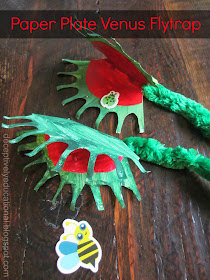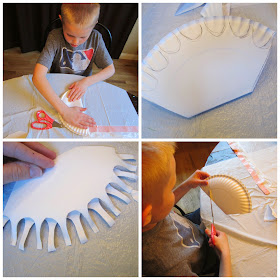The other day in the car, my eight-year-old son and I
were talking and, for a reason which now escapes me, the conversation gravitated to the
venus flytrap, that crazy carnivorous plant that eats bugs.
Having watched a Wild
Kratts tv show episode on these mind-boggling plants, I knew we had to
capitalize on my son's burgeoning interest.
This craft made hands-on learning possible.
All you need is a glue gun, scissors, two paper plates,
green and red paint, paintbrushes, and a green giant (1.9m) chenille pipe
cleaner. Markers and bug stickers are optional but highly recommended.
Here's how we did it (although you can probably just look
at the pictures to figure out it).
Fold a paper plate in half. Trim the corners. Cut
"u" shapes out of the edge of each side of the paper plate. Offset
the fringe on the second side so they fit between each other when closed.
Cut the center out of the second plate. Fold the circle
in half. Put it inside the fringed plate and cut the corners that overhang.
Paint the outside of the fringed plate green. We used acrylic craft paint. (Use a hair
dryer to speed up drying time if necessary.) Paint the fringe on the other side
of the plate (the middle of the plate will be covered with the clipped circle
so you don't have to paint it).
Paint one side off the clipped circle red.
When the paint has dried, an adult should place a bead of
glue from a glue gun in the center of the painted fringed plate along the fold.
Place a giant green chenille stem there to glue it in place.
Glue the red clipped circle over the top of the chenille
stem, on the inside of the fringed plate.
Ta-da! Now you can add trigger hairs to the inside of the
flytrap with marker and/or add bug stickers.
Your venus flytrap is done!
Our boys both had a blast with this craft. The oldest was able to do all the steps himself (with the exception of using the glue gun). Our youngest (age 4 1/2) loved painting the cut out shapes. Both had a blast trapping our foamies bugs!
We read some great books to learn about carnivorous plants. All of these were a hit with us.
After learning about pitcher plants in one of the books, my oldest boy is now begging me to help him craft one. We may end up with a whole bouquet of these meat-eating plants!
This craftivity was adapted from Teaching Little Learners.









.jpg)









































